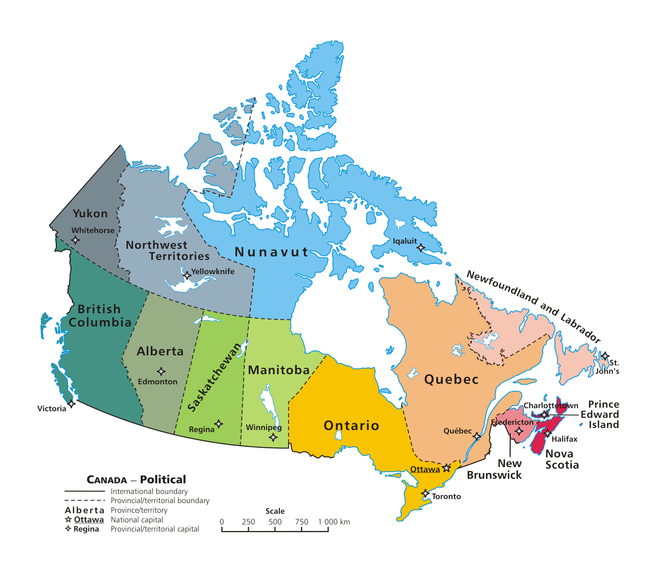
Provinces and territories
Canada is a federation composed of ten provinces: British Columbia, Alberta, Manitoba, New Brunswick, Newfoundland and Labrador, Novo Scotia, Ontario, Prince Edward Island, Quebec, Saskatchewan, and three territories: Northwest Territories, Nunavut, Yukon. In turn, these may be grouped into regions: Western Canada, Central Canada, Atlantic Canada, and Northern Canada (Eastern Canada refers to Central Canada and Atlantic Canada together). Provinces have more autonomy than territories. The provinces are responsible for most of Canada's social programs (such as health care, education, and welfare) and together collect more revenue than the federal government, an almost unique structure among federations in the world. Using its spending powers, the federal government can initiate national policies in provincial areas, such as the Canada Health Act; the provinces can opt out of these, but rarely do so in practice. Equalization payments are made by the federal government to ensure that reasonably uniform standards of services and taxation are kept between the richer and poorer provinces.

Economy
Canada is one of the world's wealthiest nations, with a 2011 nominal GDP of approximately US$1.75 trillion, and a very high per-capita income. It is a member of the Organisation for Economic Co-operation and Development (OECD) and the G8, and is one of the world's top ten trading nations. Canada is a mixed economy, ranking above the US and most western European nations on the Heritage Foundation's index of economic freedom. The largest foreign importers of Canadian goods are the United States, the United Kingdom, and Japan.
In the past century, the growth of Canada's manufacturing, mining, and service sectors has transformed the nation from a largely rural economy to an advanced, urbanized, industrial one. Like many other First World nations, the Canadian economy is dominated by the service industry, which employs about three-quarters of the country's workforce. However, Canada is unusual among developed countries in the importance of its primary sector, in which the logging and petroleum industries are two of the most prominent elements.
Canada is one of the few developed nations that are net exporters of energy. Atlantic Canada possesses vast offshore deposits of natural gas, and Alberta also hosts large oil and gas resources. The immense Athabasca oil sands give Canada the world's second-largest proven oil reserves, after Saudi Arabia. Canada is additionally one of the world's largest suppliers of agricultural products; the Canadian Prairies are one of the most important global producers of wheat, canola, and other grains. Canada is the largest producer of zinc and uranium, and is a leading exporter of many other natural resources, such as gold, nickel, aluminum, and lead. Many towns in northern Canada, where agriculture is difficult, are sustainable because of nearby mines or sources of timber. Canada also has a sizable manufacturing sector centred in southern Ontario and Quebec, with automobiles and aeronautics representing particularly important industries.
Canada's economic integration with the United States has increased significantly since World War II. The Automotive Products Trade Agreement of 1965 opened the country's borders to trade in the automobile manufacturing industry. In the 1970s, concerns over energy self-sufficiency and foreign ownership in the manufacturing sectors prompted Prime Minister Pierre Trudeau's Liberal government to enact the National Energy Program (NEP) and the Foreign Investment Review Agency (FIRA). In the 1980s, Prime Minister Brian Mulroney's Progressive Conservatives abolished the NEP and changed the name of FIRA to "Investment Canada", in order to encourage foreign investment. The Canada – United States Free Trade Agreement (FTA) of 1988 eliminated tariffs between the two countries, while the North American Free Trade Agreement (NAFTA) expanded the free-trade zone to include Mexico in 1994. In the mid-1990s, the Liberal government under Jean Chrétien began to post annual budgetary surpluses, and steadily paid down the national debt.
In 2008, Canada's imported goods were worth over $442.9 billion, of which $280.8 billion originated from the United States, $11.7 billion from Japan, and $11.3 billion from the United Kingdom. The country’s 2009 trade deficit totaled C$4.8 billion, compared with a C$46.9 billion surplus in 2008.
The global financial crisis of 2008 caused a major recession, which led to rising unemployment in Canada. As of October 2009, Canada's national unemployment rate stands at 8.6 percent. Provincial unemployment rates vary from a low of 5.8 percent in Manitoba to a high of 17 percent in Newfoundland and Labrador. Between October 2008 and October 2010, the Canadian labour market lost 162,000 full-time jobs and a total of 224,000 permanent jobs. Canada's federal debt is estimated to total $566.7 billion for the 2010–11 fiscal year, up from $463.7 billion in 2008–09. Canada’s net foreign debt rose by $41 billion to $194 billion in the first quarter of 2010.
